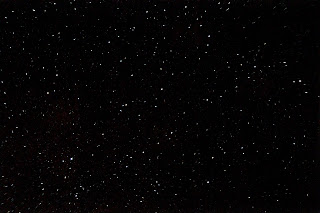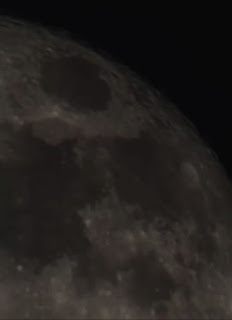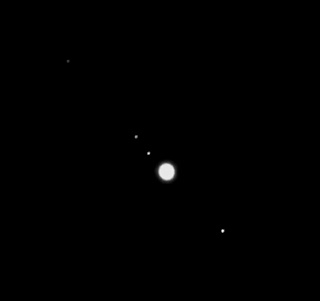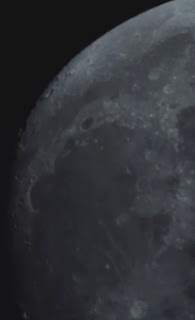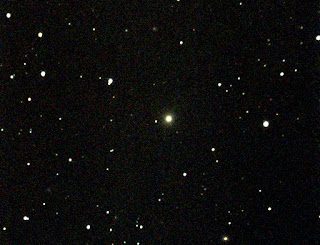April 30th 2045 GMT Moon and Jupiter
I photographed the Moon and Jupiter together with my DSLR
camera at 135mm focal length, ISO 1600 and 1/25 second exposure.
I photographed Jupiter's moons with the Seestar S50.
I changed the magnification of the Seestar S50 to 4x and
turned the exposure and gain settings to minimum to try to catch Jupiter's
details. I did not and think it was due to Jupiter being low in the twilight.
I used the Seestar S50 to capture full disc Moon shots.
I combined the above three photos to show a composite.
I took a lunar close-up at 4x magnification with the Seestar S50, featuring Mare Crisium.
April 30th 0830 GMT Sun
I photographed the Sun with my DSLR camera and Mak telescope
at my usual settings of 1.54m focal length, ISO 100 and 1/500 second exposure.
A new sunspot group had rotated on from the far side.
April 29th 2100 GMT Moon and Jupiter
The Moon and Jupiter were low in the west.
I photographed the Moon with Jupiter using my phone camera
at default settings.
I used the Seestar S50 to take multiple Moon shots.
I photographed Jupiter's moons with the Seestar S50.
I boosted the magnification of the Seestar S50 to 4x and
turned down brightness and gain to try for planetary details. I did not capture any.
I combined the three above photos to form a composite showing the moon and Jupiter's moons.
April 29th 0840 GMT Sun
It was bright and sunny with a little haze. The sun seemed
unusually quiet and I photographed it with my Mak telescope and DSLR camera at
1.54m focal length. ISO 100 and 1/500 second exposure.
April 28th 2200 GMT Deep Sky Session
This was an interesting session that did not go as planned.
I was hoping to take multiple exposures of the galaxies M51 and M101 but there
was haze that meant I did not get what I wanted.
I photographed the galaxy NGC5033 with the Seestar S50 at 10 minutes exposure.
The Iris Nebula (NGC7023) took 10 minutes with the Seestar S50.
I did 4 minutes on the Elephants Trunk Nebula with the Seestar S50. Although the dark nebula is clear, I mentally marked it as an object to revisit.
I stacked some Bubble Nebula (NGC7635) shots with a total exposure time of 24 minutes with the Seestar S50.
April 28th 2056 GMT Jupiter
I did not find Jupiter immediately, so I aimed at the bright
star Capella, as this often fine tunes the Seestar S50. I was surprised to see
a faint star close to it. It was probably a line-of-sight issue as Capella is
not known to have fainter companions.
I then found Jupiter quite quickly and did my usual shot of
the moons then fainter shots of the planet.
April 28th 1645 GMT Sun
April 27th 1035 GMT Sun
I used the Seestar S50 to look at the Sun. The full disc
shot showed poor contrast.
I took some close-ups at 4x magnification.
When I switched to scenery mode, the Sun showed better contrast at full disc but not after processing.
April 25th 2215 GMT M101 and M57
Despite the light cloud, I decided to take some multiple
images of the galaxy M101 and the Ring Nebula (M57) with the intention of
stacking.
I took 5 minute exposures of M101 and 2 minute exposures of the Ring Nebula.
I stacked 5 images of M101.
The stack of the Ring Nebula (M57) did not work, so I processed a single image.
April 24th 2215 GMT M101 and North America Nebula
I took both my Seestar S50 and DSLR camera for a short
session.
I used the Seestar S50 to capture multiple 5 minute runs of the galaxy M101. I stacked them and used GraXpert to remove the haze, before finishing in GIMP.
I took shots of Vega and Epsilon Lyrae to test focus at
300mm focal length, ISO 6400 and 2 seconds exposure.
I took one set of shots of the North America Nebula at 300mm
focal length, ISO 6400 and 2 seconds exposure. I did not catch anything.
I took another set of photos of the North America Nebula at 100mm focal length, ISO 6400 and 6 seconds exposure.
April 21st 2140 GMT Double Whammy
I set up my DSLR camera to take photos every 6 seconds at 18mm focal length, ISO 6400 and 6 seconds exposure in an attempt to capture some Lyrid meteors.
I processed 40 images, stacked them in Sequator, removed the background in GraXpert and finished in GIMP. I caught the constellations of Lyra, Hercules and Corona Borealis.
In the meantime, I used my Seestar S50 to do some deep sky shots.
M52 took 8 seconds with the S50.
I tried for the Cat's Eye nebula (a planetary nebula). I used 14 minutes but ended up with a small, faint smudge near the bottom of the image and slightly left of centre.
I used 7 minutes exposure with the S50 to catch the star cluster M39 in Cygnus.
The S50 took 5 minutes on the globular cluster M10.
The S50 took 3 minutes on the globular cluster M12.
The S50 took 3 minutes on the globular cluster M14.
I stacked 3 images of the globular star cluster M107 with the Seestar S50 for a total of 22 minutes.
April 21st 2035 GMT Jupiter
I increased the magnification to 4x to try to capture some
surface details.
I combined the two photos.
April 21st 1526 GMT Sun
Unlike the day before, I was able to photograph the sun with the Seestar S50.
April 20th 1115 GMT Sun
After the Seestar S50 failed to find the sun, I checked it with my
binoculars and filters to show four small sunspots.
April 20th Rediscovered Image
I found an image of the galaxy M106 in my Seestar gallery, which I downloaded and edited.
April 18th 2300 GMT Deep Sky Session
I went out with the Seestar S50 and photographed M5 and M40 before cloud rolled in.
The globular star cluster M5 took 1 minute of exposure with the S50 before it started to become overexposed.
The double star M40 took less than a minute before it became clear. It is in the centre of the image.
April 17th 0815 GMT Sun
I used the Seestar S50 to photograph the Sun taking full disc shots and some sunspot closeups at 4x magnification.
I also tried to capture Venus but, for some reason, it
failed.
April 13th 2145 GMT Moon and Globular clusters
I used the Seestar S50 to capture the full disc Moon then increased the magnification to 4x to take some close-ups.
April 13th 2020 GMT Jupiter's Moons
There was a brief opportunity to capture Jupiter's moons with the Seestar S50.
April 12th 2245 GMT Moon
Despite a cloudy day and a forecast of rain, the sky cleared unexpectedly. It was too late for Jupiter but the Moon was in a clear patch of sky. I took out the Seestar S50 and photographed the Moon at full disc then some closeups of interesting regions at 4x magnification.
April 11th 2000 GMT Jupiter and Moon
I photographed Jupiter's moons with the Seestar S50.
I increased the magnification to 4x and turned down the
brightness to try to capture the cloud belts.
I combined the two photos above.
I shot the Moon at full disc.
I increased the magnification to 4x to capture some areas of interest.
Despite the bright moonlight, I tried to capture a comet. I didn't!
April 11th 1000 GMT Sun and Venus
I took the Seestar S50 out and did a full disc solar shoot.
I followed up with some close-ups of 3 sunspot groups at 4x magnification.
For the first time, I tried Venus. For the initial search, I
left the Sun filter on. When I removed it, I saw a thin crescent.
I increased the magnification of the Seestar S50 to 4x and took a few shots, with the intention of stacking. I just chose the best of 4 images.
April 10th 2045 GMT Jupiter and Moon
I photographed Jupiter's moons with my Seestar S50.
I turned the brightness and gain of the S50 right down but
took multiple images of Jupiter, with the intention of stacking.
I combined the image of Jupiter with moons with the stacked image of Jupiter to form a composite.
I used the Seestar S50 to take full disc and close ups of
the Moon. For the full disc shots, I took multiple images to try to stack them. This worked.
April 9th 2030 GMT Jupiter and Moon
I photographed Jupiter's moons with the Seestar S50 at 2x
magnification.
I took multiple images of the full lunar disc with the
intention of stacking.
I then did some lunar closeups at 2x magnification.
I then tried framing mode with the Seestar S50 on M44. The best shot was 45 minutes exposure of overlapping frames.
April 9th 0915 GMT Sun
It was the day when I finally used the Seestar S50 on the
Sun. It did not manage to centre the Sun but it was near enough for me to
adjust it.
First I took a few images of the whole disc. I stacked 5 of them.
I then used 4x magnification to capture two different
sunspot groups.
I was surprised that the S50 filter showed the Sun in red, rather like my solar hydrogen alpha telescope. I felt that my Mak/DSLR combination gave better results but it was early days. The S50 seemed to produce more Newton's rings.
April 8th 2040 GMT Jupiter and Moon
I used the Seestar S50 to photograph Jupiter's moons.
As the day before, I used the Seestar S50 to take 5 full disc images of the moon and stack them.
I proceeded with shots at 2x and 4x magnification.
April 7th 2100 GMT Jupiter and Moon
I used the Seestar S50 to capture Jupiter's moons at 4x
magnification and I lowered the exposure and gain.
I took some shots of the star cluster M48 but had problems
with images being photobombed by satellites.
I took five shots of the Moon at 1x magnification to get the whole disc in and hoped to stack the images to see whether I could improve them. The stack ran quickly, suggesting that I might be able to stack more images on my PC.
I then proceeded to take shots at 2x and 4x magnification.
April 7th 0940 GMT Sun
I photographed the sun with my usual set-up and settings, my Mak and DSLR at 1.54m focal length, ISO 100 and 1/500 second exposure.
April 6th Moon and Jupiter
I photographed the Moon and Jupiter with my Seestar S50.
I took photos of Jupiter with moons and low brightness to try to capture cloud details.
I took some full disc, half disc and close-up shots of the
Moon at1x, 2x and 3x magnification.
I photographed the globular cluster M53.
I photographed the galaxy M84, also capturing the
neighbouring galaxy M86 plus a few background galaxies.
April 6th 0725 GMT Sun
I snapped the Sun with my Mak and DSLR with my Maksutov
telescope and DSLR camera at 1.54m focal length, ISO 100 and 1/500 second
exposure.
April 5th 2115 GMT DSLR Camera Shoot
I photographed the Moon with Mars with my DSLR camera at
300mm focal length, ISO 400 and 1/20 second exposure.
I photographed the Moon on its own at 300mm focal length,
ISO 100 and 1/500 second exposure.
I photographed Jupiter at 300mm focal length, ISO 100 and 1/200 second. It sometimes works! It didn't. The images looked like the Owl Nebula.
I tried for its moons at 300mm focal length, ISO 6400 and
1/20 second exposure. These didn't work, either.
It was a disappointing session with nothing good enough for my monthly gallery.
April 4th 1550 GMT Sun and Moon
I snapped the Sun with my DSLR and filter at 300mm focal
length, ISO 100 and 1/500 second exposure. I caught some sunspots but did not nail the focus.
I photographed the Moon with my DSLR at 300mm focal length,
ISO 400 and 1/400 second exposure. I did not catch anything useful at all.
April 3rd 0910 GMT Sun
I photographed the Sun with my usual method with my Mak and DSLR at 1.54m focal length, ISO 100 and 1/500 second exposure.
April 2nd 2100 GMT Galaxy Hunt
I used the Seestar S50 to hunt galaxies in and around the Virgo cluster.
M49 took 9 minutes exposure.
M58 took 6 minutes exposure.
M59 took 6 minutes exposure.
M61 took 6 minutes exposure.
M84 took 6 minutes exposure.
M85 took 6 minutes exposure.
M88 took 6 minutes exposure.
M89 took 6 minutes exposure.
M90 took 7 minutes exposure.
M91 took 6 minutes exposure.
M98 took 7 minutes exposure.
M104 took 7 minutes exposure.
M105 took 7 minutes exposure.
I did two minutes with M44m (the Beehive) but this was no better than my first attempt a few days before.
April 2nd 1910 GMT Moon and Jupiter
I used my DSLR camera to photograph the Moon with Jupiter at
100mm focal length, ISO 400 and 1/40 second exposure.
I used my Seestar S50 to photograph Jupiter's moons. I tried
turning down the gain and exposure to try and capture some planetary detail.
The Jupiter shot showed cloud belts but was no better than what I can do with my DSLR camera.
I combined the two photos to show both the planet and its moons.
I proceeded to do a Moon shoot with my S50.
I combined this shot and the one of Jupiter with its moons to form a composite image.
April 2nd 1010 GMT Sun
I photographed the Sun with my Mak and DSLR at 1.54m focal length. ISO 100 and 1/500 second exposure. The stack crashed, so I processed a single image.
April 1st 2025 GMT Moon and Jupiter
The first lunar image with my S50 was full disc.
The next two images with my S50 were at 2x magnification.
The next four images with the S50 were at 4x magnification.
April 1st 1000 GMT Sun
I photographed the Sun with my usual setup of my Mak and
DSLR at 1.54m focal length, ISO 100 and 1/500 second exposure. There was
a new sunspot group on the Eastern limb.
April 1st 0020 GMT Deep Sky
My first action of the month was to photograph the Ring
Nebula (M57) and the globular cluster M56 with the Seestar S50.
The Ring shot was from 2 stacked images, 3 minutes exposure in total and I had to reduce the brightness.
For the M56 shot, I stacked 2 images for 5 minutes exposure.

































